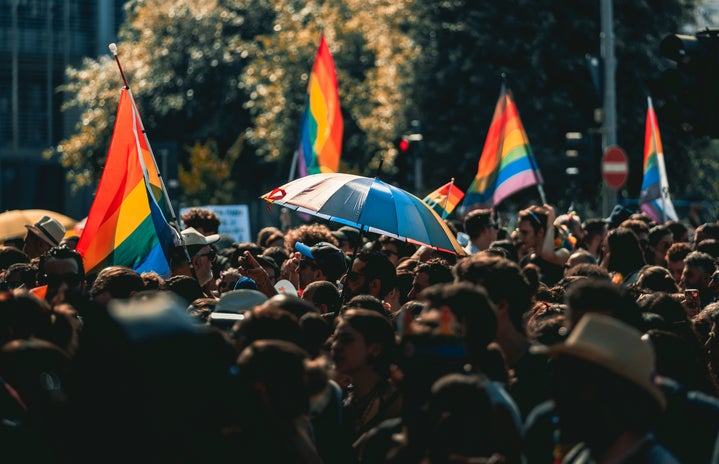The flag of rainbow colors fluttered freely on 6th September 2018 when the Supreme Court of India declared Section 377 of the Indian Penal Code to be unconstitutional, thereby decriminalizing homosexuality in the country. It was a day of pride and freedom. It was the day when the queer community was happy and gay (pun intended) but has this liberty and freedom of existing actually trickled down to every section of Indian society?
Movies and TV shows are important in portraying the marginalized sections of society. The representation of the members of the LGBTQ+ community in mainstream media forms has gone through an evolution in the past years. While initially, the world had ignored and avoided queer narratives and characters completely, soon they started bringing them in mostly to add comic relief. The queer characters were mainly gay men who were extremely effeminate to the extent of being ridiculed and were often seen as the token ‘women’ or the ‘gay best friend’ of the female lead. The queer characters had no actual relevance to the plot but were excused as side characters. However, as the world progressed and different pride movements swept international news, the mainstream media had to acknowledge the reality of queerness in the world.
The old representation of the LGBTQ+ was done from a hetero-patriarchal gaze. It saw gay men as a joke while lesbians were fetishized. They never gave much screen-time to transfolk or asexuals or even to non-binary genders. Freedom from this hetero-patriarchal gaze is a difficult battle to win.
Here, we have a list of characters from movies and shows who have liberated themselves from this outdated idea of queerness, from their closets and from the hetero-patriarchal gaze:
Eric Effiong from Sex Education
Sex Education gives us the complex and nuanced character of Eric Effiong. He hails from a West African family and so this character has a crucial diaspora attached to him. Eric is a gay teen and his exploration of his sexuality, like other characters of the show, becomes one of the key points of the main narrative. The creators of the show did not shy away from creating a character whose racial identity overlapped with his sexual identity, adding in complex themes of familial stress which is rooted not in plain homophobia but concern over one’s security. Eric’s relationship with his family and friends is an important aspect of his character but his personal growth,as he faces a traumatic homophobic assault but learns to grow through it and be a brave man, cannot be ignored. Eric Effiong is thus a queer character who has layers about him and is not a one-dimensional character added for the sake of diversity.
Kartik and Aman from Shubh Mangal Zyada Savdhan
As the story of Kartik and Aman, a gay couple who face the heteronormativity and homophobia of Indian society and aim towards emerging victorious on the other end, this movie was groundbreaking due to its prevalence in the mainstream, commercial cinema which gave it a voice that previous Indian movies and shows could not. While some critics believe that the story could have been more developed and nuanced, this movie deserves a place in this list because of its nonchalant portrayal of queer struggles and the fact that this movie introduced the discourse of homosexuality in Indian households.
Laila from Margarita with a Straw
A 2015 movie that dealt with homosexuality and disability, Margarita with a Straw was a movie created and released ahead of its time. The plot revolves around Laila, the protagonist, who suffers from cerebral palsy, and explores her bildungsroman as she grows from a sheltered teenager to an independent woman across continents. The movie is laudable especially in its casual yet emotionally moving portrayal of the intersectionality of disability and homosexuality. Often, the sexualities of the differently-abled are not explored but here, the creators have crafted a character who is more than her disability. Laila’s relationships and her quest to gain independence form the very base of this movie.
Raymond Holt from Brooklyn 99
Brooklyn 99 is already lauded for its spectacular comic portrayal and its way of dealing with serious issues. Raymond Holt is an amazing character who is not only funny but is nuanced in himself. In the very first episode of the first season, Raymond Holt, the captain of the 99th precinct, is explicitly stated to be gay. The beauty of this representation lies in the fact that his homosexuality is never used as a highlighted fact but is sprinkled in the background, just like any other hetero normative relationship would. Raymond Holt’s character is definitely a nuanced character who challenges the one-dimensionality and the stereotypes of the ‘flamboyant gay’ character, liberating him from the hetero patriarchal gaze.
Sita and Radha from Fire
A controversial Indo-Canadian movie by Deepa Mehta, Fire was released in 1996 and is one of the greatest and most critically acclaimed representations of queer romances in India. It deals with the love story of two sisters-in-law in a Hindu household in Delhi and when first released, it broke all previously-set barriers of queer representation. The movie challenges the heteronormativity prevalent in patriarchal spaces by making two women fall in love with each other.
Mainstream media needs to tell us the stories of real and nuanced characters from the LGBTQ+ community to represent reality and liberate queer narratives from the clutches of a homophobic culture that sees queer folk as one-dimensional and shallow side-characters of the world.


